“Forms” in Zen lingo means the way we embody our practice while at the temple, rooted in the experience of zazen. An important feature of engaging with the forms is to harmonize with one another in the temple as we move, sit, walk, and encounter each other and all things with which we come into contact. Many of these forms may seem restricting or unnatural. As we work with them, we can feel their beneficial effects. If you are new to practice, just follow along with others. If you have questions, ask an experienced practitioner. We also teach the forms in our weekly zazen instruction sessions and in regularly offered classes called “Next Steps”.
The forms are specific ways in which we sit, stand, walk, eat, chant, express gratitude and interact with each other. The list below defines and describes the basic ones, in some cases using Japanese words since the forms come to us from the Japanese Zen tradition in which we practice. Thank you for your inquiry into the forms – a way to express a mark of our practice is menmitsu no kafu, “careful attention is the family style”.
Basic Zendo Forms
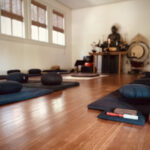
Entering the Zendo
Please leave shoes, jackets, hats, bags and water bottles in the foyer. Leave cellphones in your car or in the foyer, set to silent mode.
You may enter or leave the zendo at the beginning or end of any period of zazen or kinhin. To enter the zendo, take a step inside and offer a gassho bow (with palms together at heart-level) to the room and proceed to an available seat (zafu/bench/chair on a zabuton). Before sitting down, stand facing your seat, bow toward it in gassho, then turn clockwise to bow toward the center of the meditation hall. Sit down and turn clockwise again to face the wall.

Bowing (prostration or “full bow”)
A full prostration begins in a standing position, then lowering to your knees, placing the hands and forearms on the floor, bringing the forehead down to the floor, and raising the palms facing upward next to your ears. Prostrating in this way is an expression of equality with all beings, of gratitude and humility.
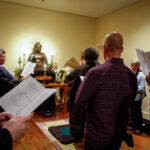
Chanting
Chanting is a body practice using your breath. The meaning of the words is not the only important element. “Chant with your ears.” Listen for the pitch and pace set by the chant leader and instruments and then adjust your tone and volume to harmonize with the assembly. Please chant with confidence. Hold the chant card or book in front of you at eye level, with thumb and pinkie outside the book, and middle fingers inside giving support to the text. Explore the variety of chants used for service.

Cosmic Mudra
Put your left hand on top of your right, middle joints of your middle fingers together, and touch your thumbs lightly to. gether (as if you held a piece of paper between them), your hands will make a beautiful oval. You should keep this universal mudra with great care, as if you were holding something very precious in your hand. Your hands should be held against your body, with your thumbs at about the height of your navel. Hold your arms freely and easily, and slightly away from your body, as if you held an egg under each arm without breaking it. You should not be tilted sideways, backwards, or towards you.

Gassho
Gassho is a gesture of respect, with hands together palm to palm, fingers pointing up, fingertips one fist’s distance from the tip of your nose.
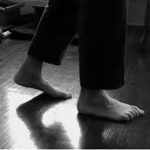
Kinhin
After the meditation bell rings twice, ending the period of zazen, bow in gassho while seated. Move off the zafu and zabuton and stand at your seat facing outwards until the beginning of walking meditation (kinhin), which is signaled by the clappers (kaishaku). Turn to the left and form a line behind the kinhin leader, who is holding the wooden clappers. Hold your hands in the shashu mudra. Take a breath and then a half step forward with your exhale. Go at your own pace but be aware of the person in front of you. The end of kinhin is signaled with another clap. Return to your place walking at a normal pace. The next period of zazen is signalled with 3 small bells. You may leave after kinhin if not sitting another period, or at the start of kinhin if you need to use the restroom or leave at that time
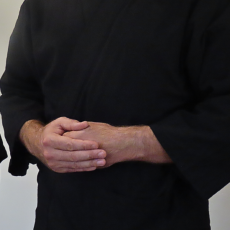
Shashu
Shashu is a posture of collected attention, with your hands held at your midriff, your left finger wrapped in a loose fist around your left thumb and the right hand covering the left. Your forearms should be parallel and relaxed. This is the posture to take while standing in the zendo or service, or while participating in kinhin.
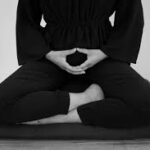
Zazen
Zazen is also a form. If you have questions about zazen please attend zazen instruction or speak with a practice leader, who can help you find a stable and comfortable sitting position and answer questions about your experiences in zazen. The list of practice leaders is available in the foyer.
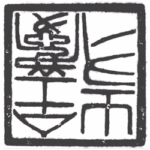
Other guidelines and forms
We maintain silence in the zendo unless a practice leader needs to offer instructions. Hold your head up and facing forward but keep your eyes lowered. Cover your cough or sneeze in the crook of your arm and blow your nose as gently as you can.
Share this:
- Click to email a link to a friend (Opens in new window) Email
- Click to share on Facebook (Opens in new window) Facebook
- Click to share on Telegram (Opens in new window) Telegram
- Click to share on Bluesky (Opens in new window) Bluesky
- Click to share on X (Opens in new window) X
- Click to share on LinkedIn (Opens in new window) LinkedIn

